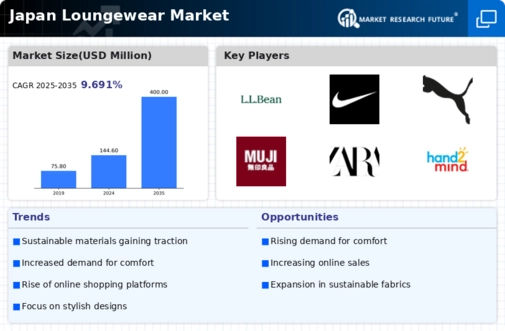The loungewear market exhibits a dynamic competitive landscape, characterized by a blend of established global brands and emerging local players. Key growth drivers include the increasing consumer preference for comfort and versatility in apparel, alongside a growing trend towards casualization in various settings. Major companies such as Nike (US), Adidas (DE), and Lululemon Athletica (CA) are strategically positioned to leverage these trends through innovation and brand loyalty. Nike (US) focuses on technological advancements in fabric and design, while Adidas (DE) emphasizes sustainability in its product lines. Lululemon Athletica (CA) continues to enhance its community engagement through local events and partnerships, collectively shaping a competitive environment that prioritizes consumer experience and brand identity.
In terms of business tactics, companies are increasingly localizing manufacturing to reduce lead times and enhance supply chain efficiency. The market structure appears moderately fragmented, with a mix of large multinational corporations and smaller niche brands. This fragmentation allows for diverse consumer choices, while the collective influence of key players drives innovation and sets industry standards.
In October 2025, Nike (US) announced the launch of its new eco-friendly loungewear line, which utilizes recycled materials and aims to reduce carbon emissions by 30% in production. This strategic move not only aligns with global sustainability trends but also positions Nike (US) as a leader in environmentally conscious fashion, appealing to a growing demographic of eco-aware consumers. The emphasis on sustainability may enhance brand loyalty and attract new customers seeking responsible purchasing options.
In September 2025, Adidas (DE) unveiled its partnership with a leading tech firm to integrate smart textiles into its loungewear collection. This collaboration aims to enhance the functionality of loungewear by incorporating features such as temperature regulation and moisture-wicking capabilities. Such innovations could potentially redefine consumer expectations and set a new standard for performance in casual wear, thereby strengthening Adidas's (DE) competitive edge in the market.
In August 2025, Lululemon Athletica (CA) expanded its retail footprint in Japan by opening three new stores in key urban areas, focusing on community-driven experiences. This expansion reflects Lululemon's (CA) commitment to fostering local connections and enhancing brand visibility. By creating spaces for community engagement, Lululemon (CA) not only boosts sales but also cultivates a loyal customer base that values the brand's lifestyle ethos.
As of November 2025, current competitive trends indicate a strong shift towards digitalization, with brands increasingly adopting AI-driven solutions for personalized shopping experiences. Sustainability remains a pivotal focus, influencing product development and consumer choices. Strategic alliances are becoming more prevalent, as companies seek to enhance their technological capabilities and market reach. Looking ahead, competitive differentiation is likely to evolve from traditional price-based strategies to a focus on innovation, technology integration, and supply chain reliability, reflecting a broader industry shift towards value creation and consumer-centric approaches.





















Leave a Comment